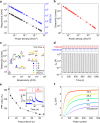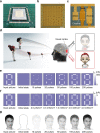A flexible ultrasensitive optoelectronic sensor array for neuromorphic vision systems
- PMID: 33741964
- PMCID: PMC7979753
- DOI: 10.1038/s41467-021-22047-w
A flexible ultrasensitive optoelectronic sensor array for neuromorphic vision systems
Abstract
The challenges of developing neuromorphic vision systems inspired by the human eye come not only from how to recreate the flexibility, sophistication, and adaptability of animal systems, but also how to do so with computational efficiency and elegance. Similar to biological systems, these neuromorphic circuits integrate functions of image sensing, memory and processing into the device, and process continuous analog brightness signal in real-time. High-integration, flexibility and ultra-sensitivity are essential for practical artificial vision systems that attempt to emulate biological processing. Here, we present a flexible optoelectronic sensor array of 1024 pixels using a combination of carbon nanotubes and perovskite quantum dots as active materials for an efficient neuromorphic vision system. The device has an extraordinary sensitivity to light with a responsivity of 5.1 × 107 A/W and a specific detectivity of 2 × 1016 Jones, and demonstrates neuromorphic reinforcement learning by training the sensor array with a weak light pulse of 1 μW/cm2.
Conflict of interest statement
The authors declare no competing interests.
Figures



References
-
- Pocock DCD. Sight and knowledge. Trans. Inst. Br. Geogr. 1981;6:385–393. doi: 10.2307/621875. - DOI
-
- Kolb H. How the retina works: much of the construction of an image takes place in the retina itself through the use of specialized neural circuits. Am. Sci. 2003;91:28–35. doi: 10.1511/2003.1.28. - DOI
-
- Lee GJ, Choi C, Kim DH, Song YM. Bioinspired artifcial eyes: optic components, digital cameras, and visual prostheses. Adv. Funct. Mater. 2018;28:1705202. doi: 10.1002/adfm.201705202. - DOI
Publication types
LinkOut - more resources
Full Text Sources
Other Literature Sources

